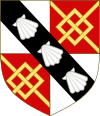George Spencer, 2nd Earl Spencer facts for kids
Quick facts for kids
The Earl Spencer
|
|
|---|---|
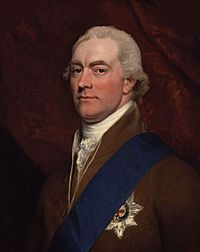
Lord Spencer by John Singleton Copley, 1800.
|
|
| Home Secretary | |
| In office 5 February 1806 – 25 March 1807 |
|
| Monarch | George III |
| Prime Minister | The Lord Grenville |
| Preceded by | The Lord Hawkesbury |
| Succeeded by | The Lord Hawkesbury |
| First Lord of the Admiralty | |
| In office December 1794 – January 1801 |
|
| Monarch | George III |
| Prime Minister | Pitt the Younger |
| Preceded by | John Pitt |
| Succeeded by | Earl St Vincent |
| Personal details | |
| Born | 1 September 1758 Wimbledon Park, London |
| Died | 10 November 1834 (aged 76) Althorp, Northamptonshire |
| Nationality | British |
| Political party | Whig |
| Spouse | |
| Children |
|
| Parents |
|
| Alma mater | Trinity College, Cambridge |
George John Spencer, 2nd Earl Spencer (born 1 September 1758 – died 10 November 1834), was an important British politician. He was a member of the Whig party.
He held several high-ranking government jobs. For example, he was in charge of the navy as the First Lord of the Admiralty. He also served as the Home Secretary, which is like a minister for internal affairs. He was the father of Father Ignatius Spencer, who became a Roman Catholic priest.
Contents
Early Life and Education
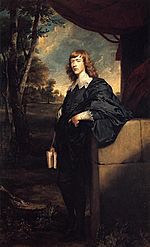
George John Spencer was born in Wimbledon Park, London. His father was John Spencer, 1st Earl Spencer, and his mother was Margaret Georgiana Poyntz. He was baptized in October 1758. Even King George II was one of his godparents!
His sister, Lady Georgiana Spencer, became very famous. She married the Duke of Devonshire and was known for hosting popular social gatherings for the Whig party.
George Spencer went to Harrow School from 1770 to 1775. He was good at archery and won the school's "Silver Arrow" prize. After Harrow, he studied at Trinity College, Cambridge, from 1776 to 1778. He earned a Master of Arts degree. When his father passed away in 1783, George became the 2nd Earl Spencer.
Political Career
George Spencer started his political journey as a Member of Parliament (MP). He represented Northampton from 1780 to 1782. Then he was the MP for Surrey from 1782 to 1783.
In 1794, he joined the Privy Council. This is a group of important advisors to the King. He worked with William Pitt the Younger, who was the Prime Minister. Spencer served as Lord Privy Seal in 1794.
His most important role during this time was First Lord of the Admiralty. He held this position from 1794 to 1801. This meant he was in charge of the British Navy during a time of war. Later, from 1806 to 1807, he became Home Secretary. He worked under Lord Grenville in a government known as the "Ministry of All the Talents."
Other Important Roles
Lord Spencer had many other public responsibilities. He was the President of the Royal Institution from 1813 to 1825. This organization supports scientific research and education.
He also became a Fellow of the Royal Society in 1780. This is a very old and respected group for scientists. In 1799, he was given a special honor, becoming a Knight of the Order of the Garter. This is one of the highest honors in Britain.
Love for Books
Spencer was very passionate about books. He especially loved early printed books. He helped start the Roxburghe Club in 1812. This was an exclusive club for people who loved collecting rare books. He was its first president.
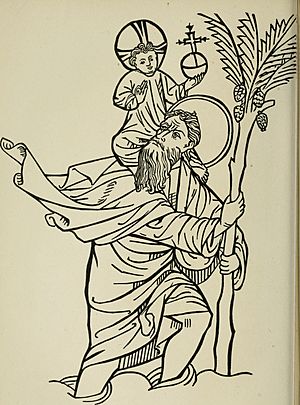
Lord Spencer built an amazing library with tens of thousands of books. His collection included almost every book ever printed by the Aldine Press. This was a famous printing house from the 15th and 16th centuries. His collection was so important that it was later bought by Enriqueta Rylands for the John Rylands Library.
He even had a special librarian named Tomaso d'Ocheda. Spencer also managed to get many rare books and old handwritten documents from religious houses in Germany. He did this when Napoleon was changing how these houses were organized.
A clergyman named Rev. Thomas Frognall Dibdin helped catalog Spencer's huge library. Dibdin wrote books describing the collection, like Bibliotheca Spenceriana. This helped people learn about the rare books at Althorp, even though the library wasn't open to everyone.
Family Life
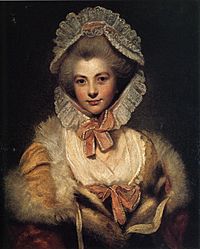
Lord Spencer married Lady Lavinia Bingham on 6 March 1781. She was the daughter of Charles Bingham, 1st Earl of Lucan. They had nine children together:
- John Charles Spencer, 3rd Earl Spencer (1782–1845)
- Lady Sarah Spencer (1787–1870)
- Hon. Richard Spencer (1789–1791)
- Captain Hon. Sir Robert Cavendish Spencer (1791–1830)
- Hon. William Spencer (born and died 1792)
- Lady Harriet Spencer (born and died 1793)
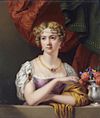
- Lady Georgiana Charlotte Spencer (1794–1823)
- Vice-Admiral Frederick Spencer, 4th Earl Spencer (1798–1857)
- Very Reverend Hon. George Spencer (later known as The Venerable Father Ignatius Spencer) (1799–1864)
Lady Spencer passed away in June 1831. Lord Spencer died three years later, in November 1834, at his home in Althorp. He was 76 years old.
The Spencer Jacket
Did you know a type of short jacket is named after George Spencer? It's called a Spencer. The story goes that his tail-coat (a long coat with tails) got burned by coals from a fire. So, he had it cut short, and this new style became popular! The military mess jacket used today is similar to this style.
Coat of Arms
|
See also
 In Spanish: George Spencer para niños
In Spanish: George Spencer para niños
- Spencer Gulf, Australia



